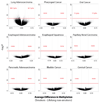Mutational signatures associated with tobacco smoking in human cancer
- PMID: 27811275
- PMCID: PMC6141049
- DOI: 10.1126/science.aag0299
Mutational signatures associated with tobacco smoking in human cancer
Abstract
Tobacco smoking increases the risk of at least 17 classes of human cancer. We analyzed somatic mutations and DNA methylation in 5243 cancers of types for which tobacco smoking confers an elevated risk. Smoking is associated with increased mutation burdens of multiple distinct mutational signatures, which contribute to different extents in different cancers. One of these signatures, mainly found in cancers derived from tissues directly exposed to tobacco smoke, is attributable to misreplication of DNA damage caused by tobacco carcinogens. Others likely reflect indirect activation of DNA editing by APOBEC cytidine deaminases and of an endogenous clocklike mutational process. Smoking is associated with limited differences in methylation. The results are consistent with the proposition that smoking increases cancer risk by increasing the somatic mutation load, although direct evidence for this mechanism is lacking in some smoking-related cancer types.
Copyright © 2016, American Association for the Advancement of Science.
Figures



Comment in
-
How tobacco smoke changes the (epi)genome.Science. 2016 Nov 4;354(6312):549-550. doi: 10.1126/science.aal2114. Science. 2016. PMID: 27811253 No abstract available.
-
Mutational signatures in oral cancer indicate a complex role for tobacco smoke carcinogens.Oral Dis. 2018 Jul;24(5):682-684. doi: 10.1111/odi.12665. Epub 2017 Apr 3. Oral Dis. 2018. PMID: 28295873 No abstract available.
References
-
- Secretan B, et al. A review of human carcinogens--Part E: tobacco, areca nut, alcohol, coal smoke, and salted fish. Lancet Oncol. 2009;10:1033–1034. - PubMed
-
- Agudo A, et al. Impact of cigarette smoking on cancer risk in the European prospective investigation into cancer and nutrition study. Journal of clinical oncology : official journal of the American Society of Clinical Oncology. 2012;30:4550–4557. - PubMed
-
- Hecht SS. Tobacco carcinogens, their biomarkers and tobacco-induced cancer. Nature reviews. Cancer. 2003;3:733–744. - PubMed
Publication types
MeSH terms
Substances
Grants and funding
LinkOut - more resources
Full Text Sources
Other Literature Sources

